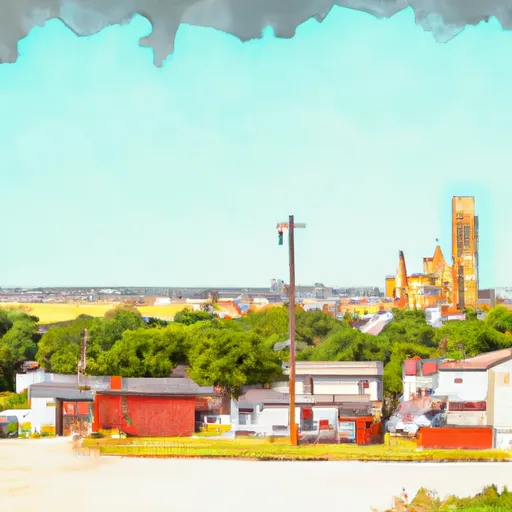-
 Snoflo Premium
Snoflo Premium
Get unlimited access to all our content
With no Ad interruptions! - Start Your Free Trial Login with existing account
Wa-Keeney
Eden Index
Climate
9.6
•
Recreation
•
Community
1.7
•
Safeguard
4.3/10

Wa-Keeney, Kansas is a small town located in Trego County, in the heart of the Great Plains. The climate in Wa-Keeney is characterized as a continental climate, with hot summers and cold winters. Summers are usually dry and hot, with temperatures reaching the mid-90s°F (35°C), while winters can be cold, with temperatures dropping below freezing and occasional snowfall.
Hydrologically, Wa-Keeney sits on the Smoky Hill River Basin, which provides a vital water source for the region. The Smoky Hill River, along with its tributaries, ensures a steady supply of water for both domestic and agricultural purposes in the area.
Despite its small size, Wa-Keeney offers several outdoor recreational opportunities. The nearby Cedar Bluff State Park, located just 20 miles south of town, is a popular destination for outdoor enthusiasts. It offers activities such as camping, boating, fishing, hiking, and wildlife viewing. The Bluffton Area Recreation Area, nestled along the shores of the Cedar Bluff Reservoir, is also a great spot for camping, fishing, and birdwatching. With the picturesque Kansas landscape as its backdrop, Wa-Keeney provides plenty of opportunities to explore and enjoy the great outdoors.
What is the Eden Index?
The Snoflo Eden Index serves as a comprehensive rating system for regions, evaluating their desirability through a holistic assessment of climate health, outdoor recreation opportunities, and natural disaster risk, acknowledging the profound impact of these factors on livability and well-being.
Climate Health Indicator (CHI): 9.6
Wa-Keeney receives approximately
579mm of rain per year,
with humidity levels near 72%
and air temperatures averaging around
12°C.
Wa-Keeney has a plant hardyness factor of
6, meaning
plants and agriculture in this region thrive during a short period during spring and early summer. Most
plants will die off during the colder winter months.
By considering the ideal temperature range, reliable water supplies, clean air, and stable seasonal rain or snowpacks, the Climate Health Indicator (CHI) underscores the significance of a healthy climate as the foundation for quality living.
A healthy climate is paramount for ensuring a high quality of life and livability in a region, fostering both physical well-being and environmental harmony. This can be characterized by ideal temperatures, reliable access to water supplies, clean air, and consistent seasonal rain or snowpacks.
Weather Forecast
Streamflow Conditions
Smoky Hill
Area Rivers
Smoky Hill
Snowpack Depths
Smoky Hill
Reservoir Storage Capacity
Smoky Hill
Groundwater Levels
Recreational Opportunity Index (ROI):
The Recreational Opportunity Index (ROI) recognizes the value of outdoor recreational options, such as parks, hiking trails, camping sites, and fishing spots, while acknowledging that climate plays a pivotal role in ensuring the comfort and consistency of these experiences.
Access to outdoor recreational opportunities, encompassing activities such as parks, hiking, camping, and fishing, is crucial for overall well-being, and the climate plays a pivotal role in enabling and enhancing these experiences, ensuring that individuals can engage in nature-based activities comfortably and consistently.
Camping Areas
| Campground | Campsites | Reservations | Toilets | Showers | Elevation |
|---|---|---|---|---|---|
| Cedar Bluff State Park - South Shore | 315 | 2,193 ft | |||
| Jetmore City Lake | 15 | 2,340 ft | |||
| Dodge City Roadside Park | 5 | 2,526 ft | |||
| Keith Sebelius Lake RA | None | 2,322 ft | |||
| Buckner Valley Park | None | 2,341 ft | |||
| Cedar Bluff State Park - North Shore | 254 | 2,168 ft | |||
| West Side Park - Beaver City | 4 | 2,175 ft | |||
| Prairie Dog State Park | 190 | 2,347 ft |
Nearby Ski Areas
Catastrophe Safeguard Index (CSI):
The Catastrophe Safeguard Index (CSI) recognizes that natural disaster risk, encompassing floods, fires, hurricanes, and tornadoes, can drastically affect safety and the overall appeal of an area.
The level of natural disaster risk in a region significantly affects safety and the overall livability, with climate change amplifying these risks by potentially increasing the frequency and intensity of events like floods, fires, hurricanes, and tornadoes, thereby posing substantial challenges to community resilience and well-being.
Community Resilience Indicator (CRI): 1.7
The Community Resilience Indicator (CRI) recognizes that education, healthcare, and socioeconomics are crucial to the well-being of a region. The CRI acknowledges the profound impact of these elements on residents' overall quality of life. By evaluating educational resources, healthcare accessibility, and economic inclusivity, the index captures the essential aspects that contribute to a thriving community, fostering resident satisfaction, equity, and social cohesion.

